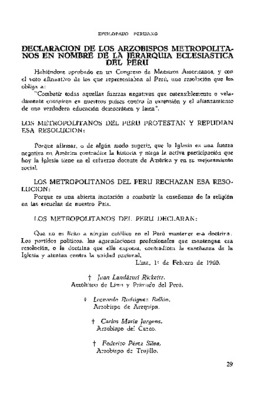| dc.contributor.author | Riofrío, Juan Carlos | |
| dc.date.issued | 2020-05-29 | |
| dc.identifier.uri | http://revistas.pucp.edu.pe/index.php/derechopucp/article/view/22110/21463 | |
| dc.identifier.uri | http://revistas.pucp.edu.pe/index.php/derechopucp/article/view/22110/22328 | |
| dc.description.abstract | The main aim of this research is to show the true dimension of the hierarchy principle, its scope and its limits. The goal is to overcome the normative vision of this principle, observing how it operates in other juridical elements, as charges, ends, values, goods, principles and rights. A philosophical, speculative and abstract method is used, endorsed with examples from the law of several nations and the international law. As the greatest debate in this field is the hierarchy of rights, viewed skeptically by a big part of the doctrine, this paper focuses on seeing how the hierarchy might work there. The analysis has a tripartite structure: a) exposition of the problem, b) exposition of notions, and c) resolution of the problem using the provided notions. In the first comprises the hierarchy principle, its positive and negative functions, and its conditions and limits, defining the possible hierarchical criteria. Finally, in the last sections, it’s checked whether the mentioned notions and criteria are applicable to the problem of rights and to other elements. After checking it the conclusions are presented.sections the arguments for and against the hierarchy of rights are exposed, andis shown where the problem of hierarchization lies. Then, it’s explained what | en_US |
| dc.description.abstract | El principal objetivo de este trabajo es mostrar cuál es la verdadera dimensión del principio de jerarquía, así como su alcance y sus límites. Se trata de superar la visión normativista del principio, observando cómo este opera en otros elementos jurídicos como los cargos, fines, valores, bienes, principios y derechos. Para ello, se utiliza un método filosófico, especulativo y abstracto, avalado con ejemplos del derecho de varias naciones y del derecho internacional. Como el punto de mayor debate en este campo se da en la jerarquía de derechos, vista escépticamente por gran parte de la doctrina, este trabajo se concentra en ver cómo podría funcionar ahí la jerarquía. El análisis tiene una estructura tripartita: a) exposición del problema, b) exposición de nociones, y c) resolución del problema aplicando las nociones aportadas. En las primeras secciones se exponen los argumentos a favor y en contra de la jerarquía de los derechos, y se muestra dónde radica el problema de la jerarquización. Luego, se explica qué comprende el principio de jerarquía, su función positiva y negativa, sus presupuestos y límites, definiendo cuáles son los posibles criterios de jerarquización. Por último, en los capítulos finales se comprueba si esas nociones y criterios resultan aplicables al problema de los derechos y a otros elementos. Tras comprobarlo, se presentan las conclusiones. | es_ES |
| dc.format | application/pdf | |
| dc.format | application/epub+zip | |
| dc.language.iso | spa | |
| dc.publisher | Pontificia Universidad Católica del Perú. Fondo Editorial | es_ES |
| dc.relation.ispartof | urn:issn:2305-2546 | |
| dc.relation.ispartof | urn:issn:0251-3420 | |
| dc.rights | info:eu-repo/semantics/openAccess | es_ES |
| dc.rights.uri | http://creativecommons.org/licenses/by/4.0 | * |
| dc.source | Derecho PUCP; Núm. 84 (2020): Derechos Humanos | es_ES |
| dc.subject | Principio de jerarquía, reglas de antinomias, jerarquía de normas, jerarquía de derechos, derechos humanos, jerarquía de principios, jerarquía de fines, jerarquía de valores | es_ES |
| dc.title | Alcance y límites del principio de jerarquía. Criterios para jerarquizar derechos, valores, bienes y otros elementos | es_ES |
| dc.title.alternative | Scope and limits of the principle of hierarchy. Criteria for hierarchizing rights, values, goods and other elements | en_US |
| dc.type | info:eu-repo/semantics/article | |
| dc.type.other | Artículo | |
| dc.subject.ocde | https://purl.org/pe-repo/ocde/ford#5.05.01 | |
| dc.publisher.country | PE | |
| dc.identifier.doi | https://doi.org/10.18800/derechopucp.202001.007 | |



